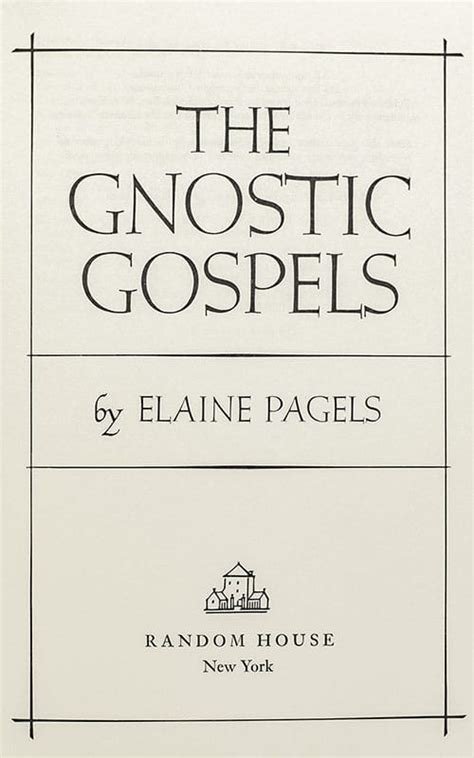Listening to the Heretics
Elaine Pagels’ The Gnostic Gospels (1979, Vintage Books) is the one book you should read to get a clean, approachable, thoughtful overview of the time, the religion and the politics of the Gnostics during their faceoff with the early orthodox church.
It’s paydirt. Pagels was involved in the early stages of codifying and translating the Nag Hammadi texts. Though unearthed (literally) in 1945, they avoided careful study for close to 30 years because of scholarly and antiquarian knee-biting. Pagels is a top-flight academic who knows the Coptic language of the texts and presents her findings and deductions in a balanced, open, engaging way. (She won the National Book Award in 1980 and a MacArthur “genius” grant the following year.)
What did it mean to be a “Gnostic” in the early days of Christianity? It’s an interesting question but a misleading one, because there was no single Gnostic point of view to match that of the rigid, institutional Catholic Church that has come down remarkably unchanged over two millennia. (To further confuse the issue, the Gnostics included many non-Christian groups.)
These twin considerations – the broad, indefinite character of Gnostic belief and the triumph of a single-outlook Church – are Pagels’ primary focuses. She lays out a delightfully informative look at the primary Nag Hammadi texts – at least those that either avowed that their contents were Christian or worked within the then-developing Judeo-Christian system.
Before the discovery of this motherload of material, the Gnostics were known mostly from the verbal attacks of their enemies; the “orthodox” church so effectively sidelined and then outlawed all alternative narratives that these “heretical” Gnostic variants sank into the realm of myth for 1600 years.
As it turns out, Iranaeus and Tertullian, the major orthodox anti-Gnostic pit bulls, painted a pretty honest picture of the major Gnostic beliefs, once you scrape off the obscuring patina of polemic. They saw the value in knowing the enemy clearly so as to neutralize them more effectively (as was the case with the 15th-century Jesuit recounters of native beliefs in the New World).
The early Church Fathers’ lambasting was so effective, Pagels points out, that until the original Gnostic texts were rediscovered, historians had assumed a clear divide between the “accepted” and the “heretical.” Yet several of the Gnostic originals make it clear that both sides – orthodox and Gnostic – saw the other as heretics.
One of Pagels’ main underlying arguments is that the orthodox had the most to gain from the vilification of their adversaries. If the Church was to survive, she says, it needed a secure, tightly organized structure that could be handed down through the ages. To establish this structure, the orthodox, through their bishops, claimed lineal descent from the Apostles: a direct pipeline to God through the approval and validation of Christ.
The Gnostics, by contrast, put far more stress on personal belief that needed no clerical justification – much as did the Protestant reformers of a millennium and a half later. With their loose, helter-skelter approach, the Gnostics had little use for imposed truth and often forcefully condemned the idea of Apostolic succession. In the eyes of the orthodox, such an unfocused, non-doctrinaire outlook undermined the organized Church’s claim to be the arbiter of truth.
What developed was a war between narrow, official belief and a wider, more diffuse version of personal revelation. As is so often the case, force and bureaucracy won out.
Pagels admits that the orthodox structure is stifling, yet she views it as the only way institutional Christianity could be maintained over the centuries. She sees this assured continuance as a good thing (I would differ), despite the loss of diversity, unconstrained thought and private acceptance of God’s message.
You might get the idea that the Gnostics developed no coherent philosophy; on the contrary, they developed several, often contradictory. Some of these systems, such as that of the most influential Gnostic theologian, Valentinus, became magnificently convoluted, but they did not describe the organization of a church on earth; rather, they detailed the spiritual metaphysics of an infinite universe.
The formulaic beliefs of many of the Gnostics can be at least as unlikely and bizarre as orthodox Christian balderdash, but they go much farther. They reach into the mind’s underground and crawl through its dank basements. They scuff up fossilized remains of thought and piece them together in an initially reasonable form that becomes, like so many human endeavors, skewed as it passes through the machinations of both linear and parallel intelligences.
By contrast, the enduring Church tossed aside anything that did not support its accepted base. The mind’s basement was walled up. As an example: Where Gnostic thought elaborated a filigreed picture of a God bursting with a multitude of emanations, the Church declared a Trinity that just “is.” Once established, the tri-partite God had no explanatory existence beyond revelation.
Later scholastic commentary that attempted to broaden the understanding of the Trinity had to work within these narrow confines, producing little but semantics. Elements inherited from other, pre-existing religions are never alluded to by the orthodox, as though the mandate of Father, Son and Holy Ghost had been slapped on the table as a finished manuscript direct from the Palmer-method hand of God.
Far from lacking depth, the Gnostics swam in the bottomless lagoon of thought. Looking for clarity in these often sunless waters is what largely set me to studying this unlikely material in the first place. And it’s what diverted me into the Bay of Rationality that is William James’ The Varieties of Religious Experience.
(Next time.)
by Derek Davis

